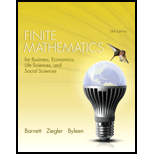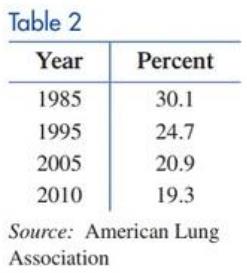
Smoking. Table 2 gives the percentage of U.S. adults who were smokers in the given year.

The following transition matrix
(A) Let
(B) Construct a new table comparing the results from part (A) with the data in Table 2.
(C) According to this transition matrix, what percentage of the adult U.S. population will be smokers in the long run?
Want to see the full answer?
Check out a sample textbook solution
Chapter 9 Solutions
Finite Mathematics for Business, Economics, Life Sciences, and Social Sciences (13th Edition)
Additional Math Textbook Solutions
Introductory Statistics
College Algebra (7th Edition)
Elementary Statistics (13th Edition)
Algebra and Trigonometry (6th Edition)
Thinking Mathematically (6th Edition)
Calculus: Early Transcendentals (2nd Edition)
- Only 100% sure experts solve it correct complete solutions need to get full marks it's my quiz okkkk.take your time but solve full accurate okkk Geometry expert solve itarrow_forward3. Let sin (22) + cos (T2) f(z) = z(22 + 1)(z+1) Compute f(z)dz over each of the contours/closed curves C1, C2, C3 and C4 shown below. L 10 -C x Don't use any Al tool show ur answer pe n and paper then takearrow_forwardwhat is the slope of the linear equation-5x+2y-10=0arrow_forward
- 1. Evaluate (2,5) (3x+y)dx+(2y-x)dy (0,1) (i) along the straight lines from (0, 1) to (2, 1) and then from (2, 1) to (2,5), and (ii) along the parabola y = x² + 1. Don't use any Al tool show ur answer in pe n and paper then takearrow_forwardDon't use any Al tool show ur answer in pe n and paper then take 20. Solve the given system of differential equations: x' = x+y, x(0) = 0 y' = 2x, y(0) = 1arrow_forward4. Verify the Cauchy-Goursat theorem for the function f(z) =225z around the closed curve C defined by a half circle || = 1 from the point (1,0) to (-1, 0) in the counterclockwise direction and then the straight line from (-1,0) to (1,0). Don't use any Al tool show ur answer in pe n and paper then takearrow_forward
- 2. Evaluate the following integral using cauchy integral theorem: ||=3 sin (22)+cos (22) (2-1)(2-2) -dz Don't use any Al tool show ur answer in pe n and paper then takearrow_forward18. Solve the given differential equation: y' + y = f(t), y(0) = 5, where f(t) = 0arrow_forward16. Solve the given differential equation: y" + 4y Given, = sin (t)u(t2), y(0) = 1, y'(0) = 0 1 = (x² + 1)(x²+4) 1/3 -1/3 + x²+1 x²+4 Don't use any Al tool show ur answer in pe n and paper then takearrow_forwardarrow_back_iosSEE MORE QUESTIONSarrow_forward_ios
 Big Ideas Math A Bridge To Success Algebra 1: Stu...AlgebraISBN:9781680331141Author:HOUGHTON MIFFLIN HARCOURTPublisher:Houghton Mifflin Harcourt
Big Ideas Math A Bridge To Success Algebra 1: Stu...AlgebraISBN:9781680331141Author:HOUGHTON MIFFLIN HARCOURTPublisher:Houghton Mifflin Harcourt Glencoe Algebra 1, Student Edition, 9780079039897...AlgebraISBN:9780079039897Author:CarterPublisher:McGraw Hill
Glencoe Algebra 1, Student Edition, 9780079039897...AlgebraISBN:9780079039897Author:CarterPublisher:McGraw Hill Linear Algebra: A Modern IntroductionAlgebraISBN:9781285463247Author:David PoolePublisher:Cengage Learning
Linear Algebra: A Modern IntroductionAlgebraISBN:9781285463247Author:David PoolePublisher:Cengage Learning Functions and Change: A Modeling Approach to Coll...AlgebraISBN:9781337111348Author:Bruce Crauder, Benny Evans, Alan NoellPublisher:Cengage Learning
Functions and Change: A Modeling Approach to Coll...AlgebraISBN:9781337111348Author:Bruce Crauder, Benny Evans, Alan NoellPublisher:Cengage Learning
 Trigonometry (MindTap Course List)TrigonometryISBN:9781337278461Author:Ron LarsonPublisher:Cengage Learning
Trigonometry (MindTap Course List)TrigonometryISBN:9781337278461Author:Ron LarsonPublisher:Cengage Learning





